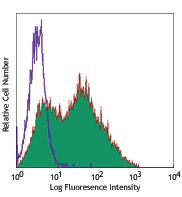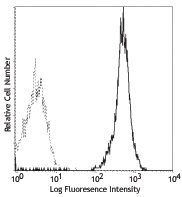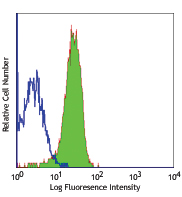- Clone
- 429 (MVCAM.A) (See other available formats)
- Regulatory Status
- RUO
- Other Names
- VCAM-1, INCAM-110
- Isotype
- Rat IgG2a, κ
- Ave. Rating
- Submit a Review
- Product Citations
- 12 publications

| Cat # | Size | Price | Quantity Check Availability | Save | ||
|---|---|---|---|---|---|---|
| 105703 | 50 µg | $77 | ||||
| 105704 | 500 µg | $268 | ||||
CD106 is a 110 kD glycosylphosphatidylinositol (GPI)-linked transmembrane protein, also known as VCAM-1 and INCAM-110. It is constitutively expressed on bone marrow stromal cells, myeloid progenitors, splenic dendritic cells, activated endothelial cells, as well as some lymphocytes. CD106 expression can be upregulated on endothelial cells by inflammatory cytokines. CD106 is involved in adhesion and acts as a counter-receptor for VLA-4 (α4/β1 integrin) and LPAM-1 (α4/β7 integrin). The 429 antibody has been reported to partially block VCAM-1-mediated binding.
Product DetailsProduct Details
- Verified Reactivity
- Mouse
- Antibody Type
- Monoclonal
- Host Species
- Rat
- Immunogen
- Mouse preadipose cell line PA6
- Formulation
- Phosphate-buffered solution, pH 7.2, containing 0.09% sodium azide.
- Preparation
- The antibody was purified by affinity chromatography, and conjugated with biotin under optimal conditions.
- Concentration
- 0.5 mg/ml
- Storage & Handling
- The antibody solution should be stored undiluted between 2°C and 8°C. Do not freeze.
- Application
-
FC - Quality tested
- Recommended Usage
-
Each lot of this antibody is quality control tested by immunofluorescent staining with flow cytometric analysis. For flow cytometric staining, the suggested use of this reagent is ≤ 0.06 µg per 106 cells in 100 µl volume. It is recommended that the reagent be titrated for optimal performance for each application.
- Application Notes
-
Additional reported applications (for the relevant formats) include: immunohistochemical staining2,3,5-7 of acetone-fixed frozen sections, blocking4,5,8 of ligand binding in vitro and in vivo, immunoprecipitation1 , and spacial biology (IBEX)11,12. The Ultra-LEAF™ purified antibody (Endotoxin < 0.01 EU/µg, Azide-Free, 0.2 µm filtered) is recommended for functional assays (Cat. No. 105727 & 105728).
-
Application References
(PubMed link indicates BioLegend citation) -
- Kinashi T, et al. 1995. J. Leukoc. Biol. 57:168. (IP)
- Koni PA, et al. 2001. J. Exp. Med. 193:741. (IHC)
- Ishiyama N, et al. 1998. Pathobiology 66:274. (IHC)
- Kinashi T, et al. 1994. Blood Cells 20:25. (Block)
- Baron JL, et al. 1994. J. Clin. Invest. 93:1700. (Block IHC)
- Buck CA, et al. 1996. Cell Adhes. Commun. 4:69. (IHC)
- Hata H, et al. 2004. J. Clin. Invest. 114:582. (IHC)
- Meunier MC, et al. 2005. Nature Medicine 11:1222. (Block) PubMed
- Monnier J, et al. 2012. J. Immunol. 189:956. PubMed
- Motohashi N, et al. 2013. J Cell Sci. 126:2678. PubMed
- Radtke AJ, et al. 2020. Proc Natl Acad Sci U S A. 117:33455-65. (SB) PubMed
- Radtke AJ, et al. 2022. Nat Protoc. 17:378-401. (SB) PubMed
- Product Citations
-
- RRID
-
AB_313204 (BioLegend Cat. No. 105703)
AB_313205 (BioLegend Cat. No. 105704)
Antigen Details
- Structure
- Ig superfamily, 47 kD
- Distribution
-
Bone marrow stromal cells, myeloid progenitors, splenic dendritic cells, activated endothelial cells
- Function
- Adhesion
- Ligand/Receptor
- VLA-4 (α4/β1 integrin) and LPAM-1 (α4/β7 integrin)
- Cell Type
- Dendritic cells, Endothelial cells, Mesenchymal Stem Cells
- Biology Area
- Cell Adhesion, Cell Biology, Immunology, Neuroinflammation, Neuroscience, Stem Cells
- Molecular Family
- Adhesion Molecules, CD Molecules
- Antigen References
-
1. Barclay AN, et al. 1997. The Leukocyte Antigen FactsBook Academic Press.
2. Kinashi T, et al. 1995. J. Leukoc. Biol. 57:168.
3. Bevilacquea MP. 1993. Annu. Rev. Immunol. 11:767.
4. Koni PA, et al. 2001. J. Exp. Med. 193:741. - Gene ID
- 22329 View all products for this Gene ID
- UniProt
- View information about CD106 on UniProt.org
Related FAQs
- How many biotin molecules are per antibody structure?
- We don't routinely measure the number of biotins with our antibody products but the number of biotin molecules range from 3-6 molecules per antibody.
Other Formats
View All CD106 Reagents Request Custom Conjugation| Description | Clone | Applications |
|---|---|---|
| Biotin anti-mouse CD106 | 429 (MVCAM.A) | FC |
| FITC anti-mouse CD106 | 429 (MVCAM.A) | FC |
| LEAF™ Purified anti-mouse CD106 | 429 (MVCAM.A) | FC, IHC-F, IP |
| Purified anti-mouse CD106 | 429 (MVCAM.A) | FC,IHC-F,IP |
| Alexa Fluor® 488 anti-mouse CD106 | 429 (MVCAM.A) | FC,IHC-F,SB |
| Alexa Fluor® 647 anti-mouse CD106 | 429 (MVCAM.A) | FC,IHC-F,3D IHC |
| PE anti-mouse CD106 | 429 (MVCAM.A) | FC |
| PerCP/Cyanine5.5 anti-mouse CD106 | 429 (MVCAM.A) | FC |
| APC anti-mouse CD106 | 429 (MVCAM.A) | FC |
| PE/Cyanine7 anti-mouse CD106 | 429 (MVCAM.A) | FC |
| Pacific Blue™ anti-mouse CD106 | 429 (MVCAM.A) | FC |
| Alexa Fluor® 594 anti-mouse CD106 | 429 (MVCAM.A) | IHC-F |
| TotalSeq™-A0226 anti-mouse CD106 | 429 (MVCAM.A) | PG |
| Ultra-LEAF™ Purified anti-mouse CD106 | 429 (MVCAM.A) | FC,IHC-F,IP |
| TotalSeq™-C0226 anti-mouse CD106 | 429 (MVCAM.A) | PG |
| TotalSeq™-B0226 anti-mouse CD106 | 429 (MVCAM.A) | PG |
Customers Also Purchased
Compare Data Across All Formats
This data display is provided for general comparisons between formats.
Your actual data may vary due to variations in samples, target cells, instruments and their settings, staining conditions, and other factors.
If you need assistance with selecting the best format contact our expert technical support team.
-
Biotin anti-mouse CD106

C57BL/6 bone marrow myeloid cells stained with 429 FITC -
FITC anti-mouse CD106

C57BL/6 bone marrow myeloid cells stained with 429 FITC -
LEAF™ Purified anti-mouse CD106

C57BL/6 bone marrow myeloid cells stained with 429 FITC -
Purified anti-mouse CD106

C57BL/6 mouse bone marrow myeloid cells stained with 429 pur... -
Alexa Fluor® 488 anti-mouse CD106

C57BL/6 mouse bone marrow cells stained with 429 Alexa Fluor... 
C57BL/6 mouse frozen testis section was fixed with 4% parafo... 
Mice were injected subcutaneously with sheep red blood cells... 
Mice were injected subcutaneously with sheep red blood cells... -
Alexa Fluor® 647 anti-mouse CD106
_AF647_CD106_Antibody_1_FC_011108.jpg&Width=150&altFmImage_path=&Crop=5)
C57BL/6 bone marrow myeloid cells stained with 429 Alexa Flu... 
C57BL/6 mouse frozen testis section was fixed with 4% parafo... 
Dissected C57/B6 mouse testis was immersed in 4% paraformal... 
Formalin-fixed, 300 micron-thick mouse testis section was bl... 
Paraformaldehyde-fixed (4%), 500 µm-thick mouse testis secti... -
PE anti-mouse CD106

C57BL/6 bone marrow cells stained with 429 PE (gated on myel... -
PerCP/Cyanine5.5 anti-mouse CD106

C57BL/6 mouse bone marrow cells stained with CD106 (clone 42... -
APC anti-mouse CD106

C57BL/6 mouse bone marrow cells stained with 429 APC -
PE/Cyanine7 anti-mouse CD106

C57BL/6 bone marrow cells stained with 429 PE/Cyanine7 -
Pacific Blue™ anti-mouse CD106

C57BL/6 bone marrow cells stained with 429 Pacific Blue&trad... 
C57BL/6 bone marrow cells stained with rat IgG2a isotype con... -
Alexa Fluor® 594 anti-mouse CD106

C57BL/6 mouse frozen spleen section was fixed with 4% parafo... 
Dissected C57/B6 mouse testis was immersed in 4% paraformal... -
TotalSeq™-A0226 anti-mouse CD106
-
Ultra-LEAF™ Purified anti-mouse CD106

C57BL/6 mouse bone marrow myeloid cells stained with 429 pur... -
TotalSeq™-C0226 anti-mouse CD106
-
TotalSeq™-B0226 anti-mouse CD106

 Login/Register
Login/Register 


















Follow Us